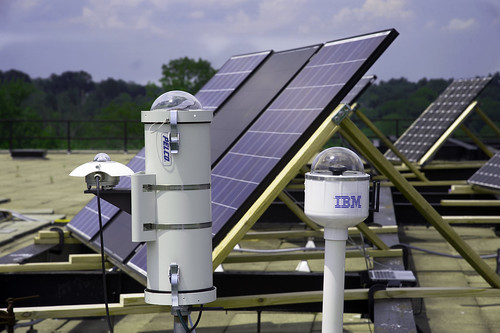The sky camera data is sent to a cognitive computer that couples this real time information with incoming weather data, such as wind speed and direction, as well as historical forecasts. The machine learning algorithms that interpret this information give us an improved picture of how much solar energy our panels are absorbing now, and how soon-to-happen weather events will affect the panels’ ability to absorb the sun’s rays.
Knowing how much solar energy we will or won’t have in the next several minutes gives a grid operator time to shift energy resources. For example, our recent Department of Energy-funded tests with “ISO-New England, the grid operator serving Connecticut, Maine, Massachusetts, New Hampshire, Rhode Island and Vermont, show that our system can be 30 percent more accurate than other state-of-the-art approaches.”
On the move with the University of Michigan
Utility grids are stationary. Put the camera in a place with an unobstructed view of the sky, and let the data roll in. So, when the University of Michigan’s solar car team asked us about using the cameras to help with forecasts for their upcoming World Solar Challenge race in Australia, we had to not only think about all the variables of it continuously seeing and understanding a new slice of sky as it cruised down the road, but also how we were going to make it mobile at all.
The solar car is a four-wheeled solar panel that can maintain speeds well above 60 miles per hour. And we would need to know at any moment the car’s solar absorption per square meter of its panel. A rental car’s roof luggage rack is not a good fit!
Thankfully, after a 600 mile mock race with the UM students, the mounting system is stable and ready for the Australian outback on October 18.
Our camera will be perched on top of UM’s weather car, which drives about 10 to 15 minutes ahead of their solar car. This allows the camera to absorb data from the approaching sky, and our system to produce a short term forecast, for the UM team. If clouds are moving toward the route, they can determine if the solar car should change its speed based on the clouds’ speed – saving valuable time and energy.
 The system will also use the camera’s data
and historical forecast data to produce a long range forecast. This prediction
gives UM a benchmark to help decide where to park the solar car during the
week-long race. Where and when the team stops will make an important difference
in how efficiently they can recharge the car’s battery via the solar panels
before nightfall.
The system will also use the camera’s data
and historical forecast data to produce a long range forecast. This prediction
gives UM a benchmark to help decide where to park the solar car during the
week-long race. Where and when the team stops will make an important difference
in how efficiently they can recharge the car’s battery via the solar panels
before nightfall.
